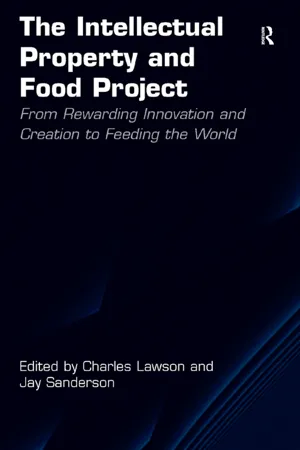10 Sen, A. 1982. Poverty and Famines: An Essay on Entitlement and Deprivation. New York: Oxford University Press. As a result of increasingly complex relations between international and domestic laws, practices and conventions, IP and food interact in infinite ways. These difficulties, however, are not reason enough to overlook the growing importance of IP to food. From our perspective, IP is not just about protecting products or process, brands, information and so on. Nor is it merely about food security and the technological imperative to produce more food. It is a much bigger project. Considering IP and food must be broad enough to include advances in science and technology, human rights, poverty, corruption and the broad expanse of insight from the effects of law and lore in delivering sufficient nutritious ‘food’ to avoidhunger. In this way the chapters in this book are designed to broadly address IP and food, and cover topics as diverse as geographic indications of tequila, water and rum, ‘patent busting’, socio-economic factors and the root causes of poverty.
This collection is the output of the IP and Food Workshop held on the Gold Coast, Australia in September 2012 and hosted by Griffith University's Australian Centre for Intellectual Property in Agriculture (ACIPA). The original purpose of the workshop was to collect together academics interested in IP and food issues and to start to traverse the various dimensions of the interaction between IP and food. Each academic was merely asked to address an issue that involves IP and food. The outcome of the workshop reflected in this collection demonstrates that IP has a multifarious and subtle interaction with food, albeit the impacts can be significantly positive and negative. The collection also reflects the immensity of the project that attempts to identify and understand the interactions between IP and food. As such, this collection is one of the early tentative steps along this path.
The collection begins with observations from Professor Robert Henry's laboratory: ‘Implications of Advances in Molecular Genetic Technology for Food Security and Ownership’. As Director of Queensland Alliance for Agriculture and Food Innovation and an internationally respected scientist (who has worked in DNA-based methods for the identification of plants, the development of molecular markers for plant breeding and the genetic transformation of plants), Henry is ideally placed to provide the scientists’ perspective on IP. Significantly, Henry provides two broad and related insights. First, scientists generally believe that ‘rapid advances in DNA sequencing technology and other technology developments have created a revolution in biology that will impact significantly on food production’. Secondly, according to Henry, in order to ensure that science and technology can reach its full potential for food production IP must be ‘streamlined’ to support emerging scientific and technical opportunities. According to Henry, for example, the use of synthetic DNA potentially necessitates the extension of plant breeders’ rights to include protection of DNA sequences to prevent the production of synthetic copies. It also appears, however, that while IP is a concern for scientists, IP itself does not appear to be impeding vital scientific research.
The remaining chapters are then organized in three groups, loosely based on common approaches, arguments or themes. The first group of chapters, ‘Public Research and Plant Germplasm_ Intellectual Property and Food Security’, focus on the increasing role of intellectual property in agricultural research and food production. In ‘Reconceptualizing Intellectual Property to Promote Food Security’ Brad Sherman examines the place of intellectual property within the CGIAR. Through a careful retracing of intellectual property within the CGIAR system, Sherman shows how there has been a shift towards using intellectual property in publicly funded agricultural research. Sherman claims that the traditional dichotomy between intellectual property and public good research – which has traditionally viewed intellectual property and public good research as mutually exclusive – has been ‘unpacked’ due to a desire to maximize the impact of agricultural research. The result of which, according to Sherman, has been the reconceptualization of intellectual property as having something to offer in the fight against poverty and food insecurity.
Charles Lawson's ‘Intellectual Property Norm Setting in ex situ Plant Germplasm Access and Benefit Sharing Arrangements’ begins by considering how the CBD and the Plant Treaty established global norms for IP in the field of plants, animals and germplasm. Significantly, however, Lawson does not focus on the treaties themselves but shifts attention to five institutions involved in implementing the CBD and the Plant Treaty, namely the: Commission on Genetic Resources; the Plant Treaty Governing Body; CGIAR Centres; Global Crop Diversity Trust; and the World Intellectual Property Organization. By contextualizing the practice of access and exchange of plant germplasm, Lawson demonstrates how these institution's policies and materials establish the way in which IP is being used in access and benefit sharing germplasm exchanges. Lawson concludes by claiming that IP may, through establishing norms for the exchange and benefit sharing of germplasm, eventually affect the price and availability of food and feed.
Brendan Tobin's ‘Open Access Seeds and Breeds: The Role of the Commons in Protecting Farmers and Livestock Keepers’ Rights and ...
